Beginner’s Guide to Counting Macros (Without Losing Your Mind)
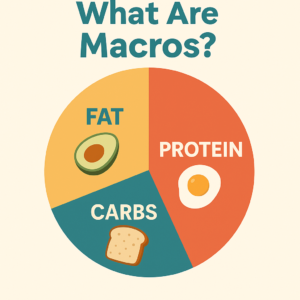
Chad Burton | Updated 6/22/2025
Let’s be real: you’ve probably heard the word macros tossed around in fitness circles like it’s some secret password to six-pack city. Or maybe you’ve seen influencers preaching the gospel of “macro balance” while holding a kale smoothie in one hand and flexing in the other.
Well guess what? You don’t need a nutrition degree or a subscription to BroScience Weekly to understand macros. And you definitely don’t need to weigh your almonds or count every gram of olive oil just to get started.
This is your NO-BS beginner’s guide to counting macros—what they are, why they matter, and how to actually use them for real, sustainable weight loss. Let’s break this thing down.
What Are Macros? (And Why Should You Care?)
Macros = Macronutrients = The Big Three:
-
-
Protein
-
Carbohydrates (Carbs)
-
Fats
-
These are the nutrients your body needs in large amounts to function. Every bite of food you eat is made up of one (or more) of these macros.
So why do macros matter?
Because calories come from macros. If you want to lose weight, gain muscle, or just have energy that lasts past 3 PM., your macro balance matters more than you think.
Macros tell your body what to do with the calories you give it.
In weight loss, macros help you feel fuller for longer, so it’s easier to consume fewer calories. If you eat the correct ratio of macros, you’ll have energy throughout day and be able to stay within your allotted calories with ease. If your macros are out of whack… well… cravings might beat you up too much.
-
-
Eat tons of carbs and no protein? You’ll crash.
-
Eat nothing but protein and fat? You might lose weight, but you’ll miss out on energy and fiber (if keto works for you, this is a fine approach! It just makes you lower-energy).
-
Balance your macros like a boss? You’ll feel fueled, lose fat, and keep muscle. Boom.
-
If you want to get started with macros, your goal should be to balance all three macro nutrients in your diet. Eat enough protein, fats, and carbs, you’re weight-loss journey will be much more enjoyable.
The Calorie + Macro Connection
Here’s the math:
-
-
1 gram of protein = 4 calories
-
1 gram of carb = 4 calories
-
1 gram of fat = 9 calories
-
So if you’re eating 1,800 calories a day, your macro ratio determines where those calories come from.
For example:
If you do 40% protein, 30% carbs, 30% fat, your daily calories break down like this:
-
-
Protein: 720 calories → 180g
-
Carbs: 540 calories → 135g
-
Fat: 540 calories → 60g
-
But don’t panic—we’ll get to the how in a sec.
What’s the Best Macro Ratio for Weight Loss?
There’s no one-size-fits-all ratio, but here’s a good starting point if you’re trying to shed fat and keep muscle: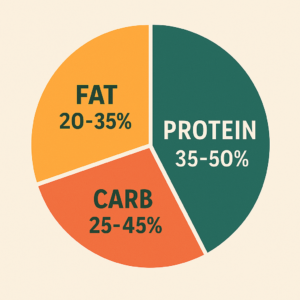
-
-
Protein: 35–50%
-
Carbs: 25–45%
-
Fat: 20–35%
-
Why?
-
-
Protein keeps you full, helps build and maintain lean muscle (which burns more calories at rest), and minimizes cravings.
-
Carbs give you energy—especially important if you’re working out or just trying to not pass out in a meeting.
-
Fat helps with hormones, feeling full, and absorbing key nutrients.
-
You can adjust depending on your goals and how your body responds.
Do I Have to Count Macros?
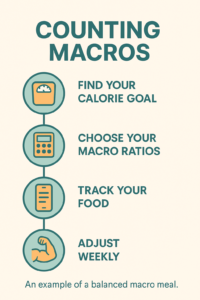
NOPE.
If counting macros feels like calculus, you can absolutely lose weight without it. Start simple:
-
-
Eat more real, non-processed foods.
-
Add a lean protein to every meal.
- Eat at least 200–300 calories of veggies a day.
-
Ditch the ultra-processed stuff 80% of the time.
-
Drink more water.
-
Stop eating when you’re full. (I know—radical.)
-
But… if you’re stuck, plateaued, low-energy, or constantly hungry?
Macros can be your secret weapon.
Okay, I’m In. How Do I Start?
Let’s go step-by-step.
✅ Step 1 & 2: Figure Out Your Calorie Goal and Macro Goal
You need a calorie deficit to lose weight. All good diets begin and end with a calorie deficit.
To find a healthy calorie-level for weight-loss and a good macro breakdown, we created this handy calculator. Fill it out and it’ll give you a great place to start.
RMR, Calories & Macros Calculator
For Weight-Loss
RMR (Resting Metabolic Rate): —
Recommended Calories / Day: —
Macros (per day):
• Protein (40 %): —
• Carbs (25 %): —
• Fat (35 %): —
✅ Step 3: Track Your Food (But Don’t Obsess)
Use MyFitnessPal, Lose It!, MacrosFirst, or any app that lets you input food and view your macro breakdown. You can even take a picture of the nutrition label and ask ChatGPT or Gemini to track it for you (it’s pretty easy).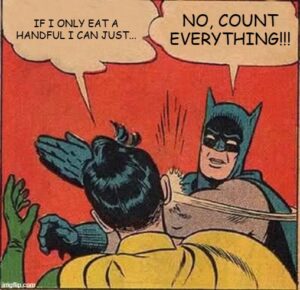
Here’s how:
- Log everything you eat (yes, even the creamer and that snack you “forgot” about).
- Check your macro summary.
- Adjust your meals to get closer to your goals.
Pro Tip: Start by focusing on protein. Most people wildly under-eat it.
✅ Step 4: Repeat & Adjust
You will NOT be perfect right away and that’s okay. At first, it may be easier to take baby-steps. See the chart in the next section to see which foods are rich in each macro, and to start, take baby-steps, like:
-
- Try to eat over 150 grams of protein a day. That’s likely not enough, but it’s a start. (See protein-rich foods below)
-
Once you reach your protein goal, add in carbs, try hit your protein target and get over 120 grams of carbs.
- Finally, add fats.
The point is, as long as you stay within your calorie count, you can build up to the correct macros.
What to Actually EAT
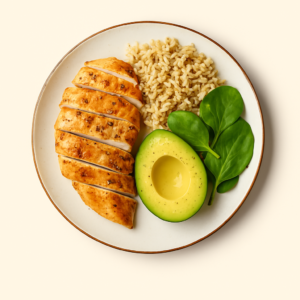 Here’s a macro cheat sheet so you’re not stuck Googling mid-meal:
Here’s a macro cheat sheet so you’re not stuck Googling mid-meal:
| Macro | Best Sources |
|---|---|
| Protein | Chicken, turkey, eggs, Greek yogurt, tofu, protein shakes/ powder, cottage cheese, tuna, lean beef |
| Carbs | Brown rice, oats, sweet potatoes, fruits, veggies, whole grain bread, quinoa, beans |
| Fats | Avocados, olive oil, nuts, seeds, nut butters, fatty fish, eggs |
- Meal Tip: Combine all 3 macros in each meal for energy, balance, and no crashes.
Common Macro Mistakes to Avoid
❌ Not eating enough protein
❌ Cutting carbs too low and wondering why you have so little energy
❌ Thinking fat is the enemy (spoiler: it’s not)
❌ Obsessing over numbers instead of learning your body
- Final Word: Macros Are a Tool—Not a Religion
- Counting macros is useful, but it’s not mandatory for weight loss.
If it makes you crazy, back off and just eat real, not ultra-processed food, meats & eggs + egg whites, and a lot of veggies.
You can always layer in macro tracking later. - But if you are ready to dial in your nutrition? Macros are one of the most effective, empowering tools you can use.
- Because once you understand what you’re eating and why, everything changes.
- TL;DR (Because I Know You Skim)
-
Macros = protein, carbs, fat.
-
They make up your calories and affect your energy, hunger, and weight.
-
Start with 40/30/30 ratio if you’re new.
-
Hit your calorie and protein goals first—worry about the rest later.
-
Don’t make it harder than it needs to be.
- Need help? Overwhelmed? Just want a simple plan to follow?
- Start by tracking one meal a day.
Then level up from there. - You’ve got this. Let’s cut the fluff and lose the weight—for good.
💪🔥
And as always, if you’re ready to start losing weight for real, check out our free Weight-Loss Starter Kit.
